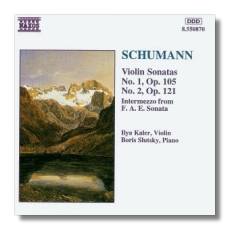
The Internet's Premier Classical Music Source
Related Links
- Schumann Reviews
- Latest Reviews
- More Reviews
-
By Composer
-
Collections
DVD & Blu-ray
Books
Concert Reviews
Articles/Interviews
Software
Audio
Search Amazon
Recommended Links
Site News
 CD Review
CD Review
Robert Schumann

Violin Sonatas
- Sonata #1 in A minor, Op. 105 (1852)
- Sonata #2 "Grand" in D minor, Op. 121 (1853)
- Intermezzo from F.A.E. Sonata in A minor (1853)
Ilya Kaler, violin
Boris Slutsky, piano
Naxos 8.550870 1994 DDD 50:59
Beethoven could sustain intense motivic development over the course of an entire large-scale composition – a passage from a Beethoven symphony is like a spoonful of a neutron star: tons of matter in a few cubic centimeters. The composers who followed the Master could achieve this kind of concentration only in shorter works like Lieder and character pieces. When they attempted something on a more ambitious temporal scale, they often ran into difficulties, especially in achieving structural coherence. Schubert and Schumann were melodists who made their greatest impact in the shorter forms and whose symphonic works have often been denigrated. Yet they both succeeded to some degree in larger forms for small groups. The intimacy of the chamber setting must have put them at their ease – the challenge of adding an appendix to Beethoven's monumental symphonic statements, on the other hand, certainly wasn't conducive to relaxation.
Schumann's first two violin sonatas, written relatively late in his career (Opp. 105 and 120, respectively), have been largely overlooked; but in recent years, we have been blessed at least one recording by a violinist of the very first rank (Gidon Kremer, with Martha Argerich on Deutsche Gramophon 419235-2 GH.). Kremer's insight into the music of this period is considerable, perhaps because of his attention to expressive detail. Ilya Kaler, whose recordings of Paganini's first two concertos and caprices (Naxos 8.550649 and 8.550717) were respectively the best and among the best in that daunting repertoire, brings to Schumann's sonatas a virtuosity no less impressive than Kremer's (although virtuosity is not the focus here), but in addition a sense of the grand sweep of the music. These works are every bit as imposing as the Piano Quintet in G minor, and Kaler's recording leaves absolutely no doubt in the listener's mind about that. His tone is rich and so well controlled as to give even the most minute expressive nuances their due. But everything unfolds naturally; there's never a sense of effects being the result of merely academic understanding. Sometimes, as a result, even the least pretentious of these effects can be overwhelming. This is romantic violin playing at its best, in repertoire that deserves a wider reputation as the among the best of its kind.
Schumann's "accompaniments," like Schubert's, are so characteristic of the composer's pianistic style that the partners must continually take heed. Kaler and Boris Slutsky understand their interrelationship in these sonatas so well that even Schumann's quintessentially pianistic figuration never detracts from a violin part that is less than optimally violinistic. The recording is well balanced, with the performers at just the right distance.
Another winning production by Naxos, which seems intent upon providing not just a respectable version of each work they record, but the very best one. This performance comes close to being just that. Given Kaler's previous issues for Naxos, that's not really a surprise. Highly recommended.
Copyright © 1996, Robert Maxham


















